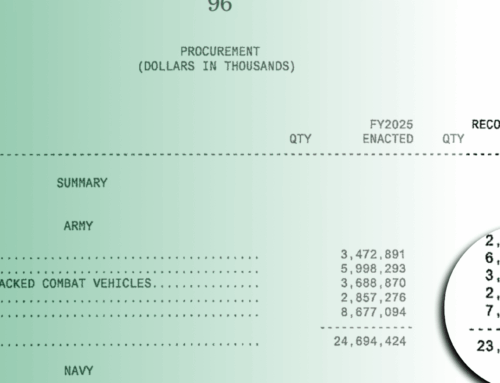Earlier this week, we explained our opposition to the House Armed Services Committee's (HASC) plan for its portion of the budget reconciliation bill Republicans are aiming to push through Congress, complete with an extra $150 billion for the Pentagon. Yesterday, despite Democratic opposition to the overall reconciliation bill, five Democrats—Reps. Jared Golden (D-ME), Gabe Vasquez (D-NM), Don Davis (D-NC), George Whitesides (D-CA), and Eugene Vindman (D-VA)—joined all committee Republicans to pass the Pentagon spending boost 35-21. It's a disappointing reminder of the bipartisan support in Congress for unrestrained Pentagon spending.
Still, some lawmakers took the opportunity to explain their opposition to the overall spending hike, as well as specific portions of the spending.
Ranking member Adam Smith (D-WA) explained his broad opposition in two parts. "First of all," he said, "it is part of the larger reconciliation bill… It increases the debt and deficit, and this is part of that overall effort… The second big problem here," he continued, "is we're giving $150 billion to this Pentagon, to Secretary Hegseth and President Trump, [when] they have not even begun to prove that there is a chance in hell that they will spend this money intelligently, efficiently, and effectively."
While those are both valid points, his second problem suggests that some other administration might be able to spend this money intelligently, efficiently, and effectively. We disagree—there's nothing intelligent, efficient, or effective about throwing another $150 billion at the Pentagon, no matter how that money is spent. Pentagon spending has grown nearly 50 percent adjusted for inflation since the turn of the century. The intelligent, efficient, and effective alternative is to force the Pentagon to work with the budget it has, which would require some strategic decision making rather than the all-of-the-above approach the Pentagon has become accustomed to.
Other lawmakers seemed to have a tighter grasp on this reality. As Rep. John Garamendi (D-CA) pointedly put it, "Why are we doing this? Have we lost our minds?… We spent a whole year going through the National Defense Authorization Act, line item by line item, committee by committee, and came to the conclusion (that) $860 billion was enough. And that was $15 billion more than the year before."
Rep. Sara Jacobs (D-CA) remarked that "we're fast tracking an authorization of $150 billion extra slush fund for war toys, including $5 billion for the military to conduct deportations, and handouts to the military industrial complex when the Pentagon has failed seven consecutive audits."
As for specific spending in the bill, lawmakers took issue with some of the same line items we opposed in our analysis.
Space-based missile defense for the Golden Dome
Rep. Eugene Vindman (D-VA) offered an amendment to redirect $2.6 billion of the $5.6 billion in the bill for "development of space-based and boost phase intercept capabilities" toward service member quality-of-life investments.
Speaking in support of the amendment, he explained that it "puts servicemembers and quality of life over what I call a pet project, the Golden Dome, this bright and shiny vanity project, which frankly, I don't know what it's supposed to do, what does it accomplish? Does it defend the homeland from strategic missile attack from China or Russia? That's not clear. There has been no clear purpose provided for $25 billion in spending. And when you balance that against the quality-of-life issues I discuss, and service members and their families, I will support servicemembers and their families every time."
Examining what the Golden Dome is meant to accomplish is the right idea. If it's meant to protect the United States from the kind of short and medium-range missiles and rockets that Israel's Iron Dome is built for, it raises the question—are Mexico and Canada threatening to attack us with such weapons? No? Then why would we spend billions on a nonexistent threat? If the idea is to defend against nuclear or hypersonic attacks from Russia or China, could we actually succeed in building a missile defense system that would thwart such attacks? Physicists are more than skeptical—in fact, some have called it an "economically ruinous and strategically unwise… fantasy."
The amendment failed 26-30.
Sentinel "risk reduction activities"
Rep. Garamendi, who has consistently opposed the Sentinel intercontinental ballistic missile (ICBM) program for years, made his case against the program once again, and the $1.5 billion for "risk reduction activities" for the Sentinel included in HASC's reconciliation package. "I'm not exactly sure what risk reduction is," he said, "in fact, I don't think any of us know what it is. It's just a $1.5 billion slush fund that the Pentagon would somehow use, presumably associated with a Sentinel." Rep. Garamendi was speaking in support of an amendment to limit funding for the program until the Pentagon approved the program for Milestone B, a key stage in acquisition that signals a program is ready to move into the Engineering & Manufacturing Development (EMD) stage.
Rep. Jacobs spoke in support of the amendment as well, placing the debate in its broader strategic context. "It's long overdue to rein in the astronomical costs of the Sentinel Program, and honestly to reassess our nuclear posture in its entirety. Increasing our land based nuclear forces to outnumber the PRC and Russia is an archaic strategy that doesn't match the realities of our new multipolar world. So, we shouldn't continuously throw hard earned taxpayer dollars at this program, especially when they haven't even finished their milestone B certification. My friend Mr. Garamendi, his amendment is simple and common sense."
The amendment failed 25-30.
Nuclear-armed sea-launched cruise missile (SLCM-N)
Rep. Gil Cisneros (D-CA) offered an amendment (with an erroneous hyperlink on HASC's markup webpage) to redirect $2.4 billion for the nuclear-armed sea-launched cruise missile, or SLCM-N, included in the bill toward service member quality-of-life investments. While Rep. Cisneros focused on the value of the funding for servicemembers and their families, Rep. Jacobs spoke up specifically in support of stripping the funds from the SLCM-N.
After HASC Chair Mike Rogers (R-AL) opposed the amendment by stating that "every senior military official who's testified about this program before this Committee has agreed it's needed," Rep. Jacobs set the record straight. "With all due respect to you, Mr. Chairman," she said, "as my friend, I think we've all actually heard a lot of skepticism from our military leaders about the feasibility, cost and consequences of the nuclear arms sea launch cruise missiles, SLCM-N. Vice Admiral Johnny Wolf, the Director of the Navy Strategic Systems Program has warned that we'll need an entirely new industrial base to achieve it and it's likely impossible on this timeline by 2034."
She also pushed back on the strategic rationale for the missiles, arguing that "these weapons are dangerous, unnecessary and wasteful and contrary to our deterrence first posture, because both nuclear armed and conventional cruise missiles look virtually the same, which escalates the risks of misunderstandings and miscalculations that could lead to a nuclear war."
The amendment failed 26-29.
Our Take
Taxpayers for Common Sense applauds those lawmakers who spoke up during the markup against the overall package, as well as some of the most egregious investments within it. Unfortunately, they were in the minority—but their leadership on behalf of American taxpayers has not gone unnoticed.










